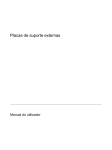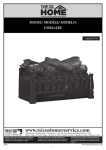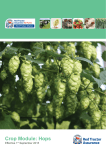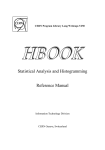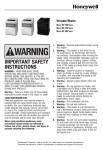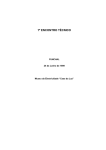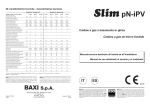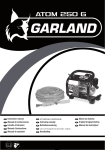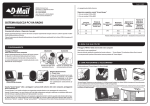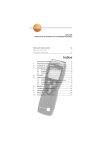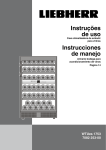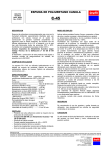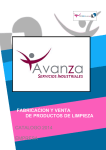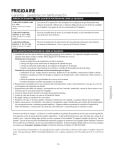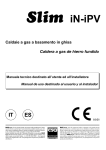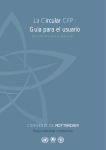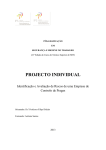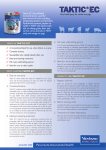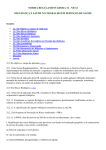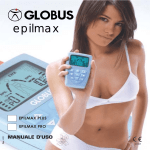Download Tech Instr ENG-28Mat2013
Transcript
Qwertyuiopasdfghjklzxcvbnmqwert yuiopasdfghjklzxcvbnmqwertyuiop asdfghjklzxcvbnmqwertyuiopasdfg hjklzxcvbnmqwe rtyuiopasdfghjklzxcvbnmqwertyuio pasdfghjklzxcvbnmqwertyuiopasdf ghjklzxcvbnmqwertyuiopasdfghjklz xcvbnmqwertyuiopasdfghjklzxcvbn mqwertyuiopasdfghjklzxcvbnmqwe rtyuiopasdfghjklzxcvbnmqwertyuio pasdfghjklzxcvbnmqwertyuiopasdf ghjklzxcvbnmqwertyuiopasdfghjklz xcvbnmqwertyuiopasdfghjklzxcvbn mqwertyuiopasdfghjklzxcvbnmqwe rtyuiopasdfghjklzxcvbnmqwertyuio pasdfghjklzxcvbnmrtyuiopasdfghjkl TECHNICAL INSTRUCTIONS NOTIFICATION PROCEDURE OF SUBSTANCES AND MIXTURES TO THE INSTITUTO NACIONAL DE TOXICOLOGÍA Y CIENCIAS FORENSES INSTITUTO NACIONAL DE TOXICOLOGÍA Y CIENCIAS FORENSES Instructions INTCF, 28th May 2013 Page 1 TECHNICAL INSTRUCTIONS NOTIFICATION PROCEDURE OF SUBSTANCES AND MIXTURES TO THE INSTITUTO NACIONAL DE TOXICOLOGÍA Y CIENCIAS FORENSES INTRODUCTION As a result of Law 8/2010 of 31 March, which establishes the sanctions regime of the (EC) Regulation concerning the Registration, Evaluation, Authorisation and Restriction of Chemical substances (REACH), and the guidelines on the Classification, Labelling and Packaging of substances and mixtures (CLP), which modifies the former Regulation, as well as the recently published Law 10/2012 of 20 November, regulating certain fees of the Administration de Justicia and the Instituto Nacional de Toxicología y Ciencias Forenses (INTCF). The Order of 7 may regulates both the notification procedure of new entries, modifications and withdrawals of toxicology files to the Registry of chemical products at the Servicio de Información Toxicológica of the Instituto Nacional de Toxicología y Ciencias Forenses, as well as fee payment procedure established by Law 10/2012 of 20 November, which applies to certain fees of the Administración de Justicia and the Instituto Nacional de Toxicología y Ciencias Forenses. Subsequent to the introduction of this policy and the development of the informatics application for the notification procedure, the Enterprise has encountered practical concerns, which have been occasionally reported to the INTCF. Thus, and in order to offer further support, the INTCF has provided a series of recommendations, which will undoubtedly facilitate the knowledge and implementation of these rather mutable and complex regulations by swiftly adapting to any potential changes. Additionally, they are meant to assist in the use of the informatics application that has been developed, which is expected to achieve a more efficient management by improving the procedure. In addition to these instructions, the companies are provided with the informatics application manual which describes the process of downloading, installing and use, as well as the enterprise user manual supplying the information required for data transfer via a Secure File Transfer Platform (SFTP). All these documents are available from the internet Justice Administration Portal. Instructions INTCF, 28th May 2013 Page 2 INDEX - The informatics application: how to download the application.: - Notifications: entries, modifications and withdrawals: - Completing the toxicology file: 1. Trade name (commercial name) 2. UPI (Unique Product Identifier): product ID 3. Person completing the file and date 4. Type of product 5. Uses 6. Hazard classification 7. Presentation 8. Colour 9. Package format 10. pH 11. Quantitative composition 12. File completed by 13. Marketing company (company responsible of placing the product on the market) 14. Information provided by 15. Attached documents - Saving the completed file - Modifications: 1. Formula modification 2. Modification of non-critical aspects 3. Modification of the product trade name 4. Updating of attached documents - Generation of the export file to notify the INTCF - Compression, encryption and signature of the export file: - Data submission to the INTCF: - By post mail (regular or express) - Via the Secure File Transfer Platform (SFTP) - Responsibility of the Companies - Receipt acknowledgement Instructions INTCF, 28th May 2013 Page 3 THE INFORMATICS APPLICATION: HOW TO DOWNLOAD THE APPLICATION The application designed for the notification procedure to the INTCF (cliente generador de fichas) will be available for the Enterprise at the Justice Administration Portal This application is totally free, both for companies for which product notification is mandatory, as well as for those willing to provide the information to the INTCF. Alternatively, the company will be able to generate directly the xml files employed by the application, following the syntax indicated in the Manual that describes how to install and use the application (Productos INT. Manual de Administrador-Usuario), so that it is compatible with the program managed by the Institute. For instance, the companies can replace the file INGREDIENTES.xml, located in directory C:/Program files/GesFicCom/ListView, by another file generated by them containing the substances currently used by the company (or by the specific industrial sector), as long as it complies with the syntax indicated in the aforementioned manual. Similarly, the companies can replace the INTCF Toxicology Information File generated by the program by their own file containing the information of the mixtures, as long as it complies with the previously indicated syntax. NOTIFICATIONS: ENTRIES, MODIFICATIONS AND WITHDRAWALS This application has been designed to notify the entries of new products, as well as the modifications and withdrawals of products that were previously registered in the INTCF databank. The tab “Management of toxicological files” (“Gestión de fichas toxicológicas”) provides the following options: - “Add” (“Añadir”): to notify the entry of a new product - “Modify” (“Modificar”): to notify changes or modifications of a previously registered product - “Withdrawal” (“Dar de baja”): to notify the withdrawal of a product from the market. Indicate date for withdrawal, considering the date when the product is out of stock for the marketing company. Instructions INTCF, 28th May 2013 Page 4 However, the product file will be stored in the INTCF databank for 10 years, because products remain available for potential poisoning long after marketing withdrawal. In order to help with file submission, the application provides three extra functions: - “Modify F Paper” (“Modificar F Papel”): to modify a product file that was reported to the INTCF before the implementation of this program. - “Copy” (“Copiar”): to prepare a product file that is very similar to a previously completed product file. This command enables to copy from the old file and modify the differing data of the new product. - “Edit” (“Editar”): to open a file and modify data before submission to the INTCF. Moreover, once submitted, the option enables to include the date of the receipt acknowledgement and the product reference number provided by the INTCF. COMPLETING THE TOXICOLOGY FILE 1. Trade name The complete trade name must be provided (in CAPITAL LETTERS), as displayed on the label, avoiding abbreviations, in order to guarantee the unambiguous identification of the specific product and discriminate the variants of a product name. Moreover, if available, indicate the register numbers displayed on the label. Although the preferred option is to fill in one file per product, an exception is allowed for variants with the same product trade name differing in colour or fragrance, but only if all variants comply with the reported concentration ranges, and if no changes affect the concentration of hazard classified ingredients included in the following categories (according to Regulation EC 1272/2008): - Acute toxicity (oral, dermal, inhalation) category 1,2 or 3 STOT- single exposure, category 1 and 2 STOT- repeated exposure, category 1 and 2 Skin corrosion, category 1A, 1B and 1C Severe eye damage category 1 In this case, remember to attach one label for each variant. You must complete a file for each product trade name, even when products with the same composition are commercialized with different product trade names. When the product is commercialized in Spain with different names (translated into Instructions INTCF, 28th May 2013 Page 5 other national languages, such as Basque, Catalan, etc.), all product names must be provided in the same Toxicology Information File. 2. Unique Product Identifier (UPI): product ID The unique product identifier is the company reference code provided by the enterprise, which identifies the composition of the mixture. Thus, it must vary for a product that, albeit preserving the trade name, actually modifies its composition over time. 3. Person completing the file and date Report the full name of the person completing the file and the date on which the file was generated. The date is provided by default; however, the user can modify it by directly typing or using the supplied calendar. 4. Type of product Report the type of product according to the classification supplied by the application, by selecting the main use of the product. - Fitosanitarios uso Agrícola (Phytosanitary products for agricultural use) o o o o o o o o o o Acaricida (Acaricides) Alguicida (Algaecides) Atrayente (Attractants) Bactericida (Bactericides) Desinfectante (Disinfectants) Fitorregulador (Phytoregulators) Fumigante (Fumigants) Fungicida (Fungicides) Herbicida (Herbicides) Insecticida inhibidores de acetilcolinesterasa (Insecticides, acetyl o o Insecticida Organoclorados (Insecticides, organochlorine) Insecticida Piretroides (Insecticides, pyretroids) Insecticida (otros) (Insecticides, others) Larvicida (Larvicides) Molusquicida (Molluscicides) Nematicida (Nematicides) Repelente (Repellents) Rodenticida (Rodenticides) Topicida (Mole pesticides) Otros Fitosanitarios uso agrícola (Other Phytosanitary products for cholinesterase inhibitors) o o o o o o o o agricultural use) - Medicamentos (Drugs for): Instructions INTCF, 28th May 2013 Page 6 o A Medicamentos Aparato digestivo y metabolismo (Alimentary tract and metabolism) o o o o o o o o o o o o o o o o B Sangre y órganos hematopoyéticos (Blood and haematopoietic organs) C Aparato Cardiovascular (Cardiovascular system) D Terapia Dermatológica (Dermatologicals) G Terapia Genitourinaria (Incl. Hormonas sexuales) (Genitourinary system, including sex hormones) H Terapia hormonal (Hormone therapy) J Terapia antiinfecciosa sistémica (Anti-infective systemic therapy) L Terapia antineoplásica y agentes inmunomodulares (Antineoplastic and immunomodulatory agents) M Aparato locomotor (Musculoskeletal system) N Sistema nervioso (Nervous system) P Antiparasitarios (Antiparasitic drugs) R Aparato respiratorio (Respiratory system) S Órganos de los sentidos (Sensory organs) V Varios (Various) Medicamentos de uso veterinario (Veterinary drugs) Fitoterapia (Phytotherapy) Medicamentos homeopáticos (Homeopathic drugs) - Productos de Limpieza (Cleaning products) It is relevant to specify the main downstream users of a product (end-users): Consumer (private household) or professional (institutional, when products are used by institutional cleaning workers or industrial, when used as cleaning products for industrial machinery). o Productos de Limpieza DOMESTICOS Cleaning Products HOUSEHOLD LD Activadores de lavado de ropa (liberadores de oxígeno) (Washing activators for laundry, active oxygen release) LD Amoniaco (Ammonia) LD Anticalcáreo, desincrustante (Scale remover) LD Desatascador (Drain cleaner) LD Desengrasante (Degreaser) LD Desinfectantes (Disinfectant) LD Detergente de ropa (Laundry detergents LD Lavavajillas a mano Dishwashing detergents (manual) LD Lavavajillas a máquina: aditivos (abrillantadores, sal,..)Dishwashing machine additives (salt, rinse and shine aids, etc.) LD Lavavajillas a máquina: detergentes Dishwashing machine detergents LD Lejía y otros liberadores de cloro (Bleaches and other chlorine based cleaners) LD Limpiacristales (Glass cleaners) LD Limpiahogar (General-purpose cleaners) LD Limpiahornos (Oven cleaners) Instructions INTCF, 28th May 2013 Page 7 LD Limpiametales (Metal cleaners, polishes) LD Limpiamuebles (Furniture cleaners and wood care cleaners) LD Limpiasuelos (Floor (hard surface) cleaners) LD Limpiavitrocerámica (Vitro ceramic cleaners) LD Limpiazapatos (Shoe cleaners) LD Limpieza de WC (con liberador de cloro) (WC cleaners, chlorine LD Limpieza de WC (sin liberador de cloro) (WC cleaners, without based) chlorine) o LD Quitamanchas (Stain removers) LD Suavizantes de ropa (Fabric conditioners) LD Otros Prod. de limpieza domésticos (Other household cleaners) Productos de Limpieza INSTITUCIONAL (grandes superficies) Cleaning Products INSTITUTIONAL (large areas) LI Abrillantadores de suelos (Floor polishes) LI Activadores de lavado de ropa (liberadores de oxígeno) (Washing activators for laundry, active oxygen release) LI Amoniaco (Ammonia) LI Anticalcáreo, desincrustante (Scale remover) LI Cristalizadores de suelos (Floor crystallizers) LI Desatascador (Drain cleaner) LI Desengrasante (Degreaser) LI Desinfectantes (biocidas uso Industria Alimentaria) (Disinfectants (biocides used in food industry) LI Detergente de ropa (Laundry detergents) LI Lavavajillas a mano (Dishwashing detergents, manual) LI Lavavajillas a máquina: aditivos (abrillantadores, sal, ...) (Dishwashing machine additives: salt, rinse and shine aids, etc.) LI Lavavajillas a máquina: detergentes (Dishwashing machine detergents) LI Lavavajillas líquidos alcalino (Dishwashing liquid alkaline detergents) LI Lejía y otros liberadores de cloro (Bleaches and other chlorine based cleaners) LI Limpiacristales (Glass-window cleaners) LI Limpiador general (General-purpose cleaners) LI Limpiahornos (Oven cleaners) LI Limpiametales (Metal cleaners, polishes) LI Limpiamuebles (Furniture cleaners and wood care cleaners) LI Limpiasuelos (Floor, hard surface cleaners) LI Limpiavitrocerámica (Vitro ceramic cleaners) LI Limpiazapatos (Shoe cleaners) LI Limpieza de WC (con liberador de cloro) (WC cleaners (chlorine based) LI Limpieza de WC (sin liberador de cloro) (WC cleaners without chlorine) LI Quitamanchas (Stain removers) LI Suavizantes de ropa (Fabric conditioners) LI Otros Prod. de limpieza institucional (Other institutional cleaners) o Productos de limpieza INDUSTRIAL (maquinaria industrial) Cleaning Products INDUSTRIAL (industrial machinery) Instructions INTCF, 28th May 2013 Page 8 Prod. Limpieza caústicos ácidos (Caustic acid cleaning products) Prod. Limpieza cáusticos alcalinos (Caustic alkaline cleaning products) Prod. Limpieza neutros (Neutral cleaning products) Otros Prod. Limpieza industrial (Other industrial cleaning products) - Cosméticos (Cosmetics) o o o o o o o o o Cosméticos cuidado de la piel (Cosmetics for skin care) Cosméticos cuidado de las uñas (Cosmetics for nail care) Cosméticos cuidado del cabello (Cosmetics for hair care) Depilatorio (Depilatory cosmetics) Desodorante (Deodorants) Higiene bucal (Oral hygiene) Jabón, geles baño, champú (Soaps, bath gels, shampoos) Lociones, colonias, perfumes (Lotions, cologne water, perfumes) Otros P. cosméticos (Other cosmetic products) - Biocidas (Biocides) o Desinfectantes y biocidas generales (Disinfectants and general biocides) B1 Biocidas para la higiene humana (Biocides for human hygiene) B2 Otros biocidas generales (desinfección del aire, piscinas, acuarios, aire acondicionado, centros sanitarios, residuos y aguas residuales, etc.) (Other general biocides (disinfection of air, swimming pools, aquariums, air conditioning systems, sanitary establishments, residues and residual waters, etc.) B3 Biocidas para higiene veterinaria (Biocides for veterinary hygiene) B4 Desinfectantes para superficies en contacto con alimentos y piensos (Disinfectants for surfaces in contact with food and feed) B5 Desinfectantes para agua potable (Disinfectants for drinkingpotable water) o Conservantes (Preservatives) B6 Conservantes para productos envasados (Preservatives for packaged products) B7 Conservantes para películas (Preservatives for films ) B8 Protectores para maderas (Wood conserving agents) B9 Protectores de fibras, cuero, caucho y materiales polimerizados (Conserving agents for fibres, leather, rubber and B10 Protectores de mampostería (Conserving agents for masonry) B11 Protectores para líquidos utilizados en sistemas de refrigeracion y en procesos industriales (Conserving agents for B12 Productos antimoho (Anti-mould products) B13 Protectores de líquidos de metalistería (Conserving agents for polymeric materials) liquids in cooling systems and industrial processes) metalwork) o Plaguicidas (Plaguicides) B14 Rodenticidas (Rodenticides) Instructions INTCF, 28th May 2013 Page 9 B15 Avicidas (Avicides) B16 Molusquicidas (Molluscicides) B17 Piscicidas (Piscicides) B18 Insecticidas, acaricidas y otros artrópodos (Insecticides, acaricides and other arthropods) o B19 Repelentes y atrayentes (Repellents and attractants) Otros Biocidas (Other Biocides) B20 Conservantes para alimentos o piensos (Preservatives for food and feed) B21 Productos antiincrustantes (Antifouling products) B22 Líquidos para embalsamamiento y taxidermia (Liquids for B23 Control de otros vertebrados (parásitos) (Control of other embalmment and taxidermy) vertebrates: parasites) - Productos del hogar (Household products) o Ambientadores (domésticos e institucionales) (Room deodorizers, household o and institutional) Cerillas (Matches) o o o o Correctores de máquina (Typewriter correctors) Prod. encendido de barbacoa (Barbecue tablets) Lápices, rotuladores, tinta (Pencils, markers, ink) Mantenimiento y limpieza del automóvil (doméstico) (Car maintenance and cleaning products, household) o P. de Bricolage (no especificados en otros apartados) (Bricolage products, not specified in other sections) o P. para mascotas domésticas (excepto med. uso veterinario) (Products for domestic pets, except veterinary drugs) o o o o PC1 Pegamentos, colas, adhesivos y sellantes (Adhesives, sealants) PC2 Adsorbentes o Desecantes (Adsorbents or Desiccants) PC9a Disolventes (uso doméstico) (Solvents, household use) PC9a Pinturas y barnices (uso doméstico) (Coatings and paints, household use) o PC9b Rellenos, masillas, yeso, arcilla de modelado (Fillers, putties, plasters, modelling clay) o o o o o o PC9c Pinturas de dedo (Finger paints) PC12 Fertilizantes (Fertilizers) PC20 Prod. para mantenimiento de piscinas (floculantes, precipitantes, neutralizantes, antialgas, control pH) (Products for swimming pool maintenance: ph-regulators, flocculants, precipitants, neutralization agents) PC24 Lubricantes, grasas y desmoldeantes (Lubricants, greases, release products) Otros productos del hogar (Other household products) - Productos industriales (Industrial products) Instructions INTCF, 28th May 2013 Page 10 o o o o o o o o o o o Aromas alimentarios (Food flavouring) Betunes, asfaltos, ceras y parafinas (Bitumen, asphalts, waxes and paraffin) Materias primas (Raw materials) PC1 Adhesivos y sellantes (Adhesives, sealants) PC2 Adsorbentes o desecantes (Adsorbents or desiccants) PC4 Anticongelantes y descongelantes (Anti-Freeze and de-icing products) PC7 Metales y aleaciones (Base metals and alloys) PC9a Decapantes (Paint and varnish removers) PC9a Disolventes (clorados) (Thinners, chlorine based) PC9a Disolventes (excepto clorados) (Thinners, except chlorine based) PC9a Pinturas y barnices (uso profesional) (Coatings and paints, professional use) o PC9b Rellenos, masillas, yeso, arcilla de modelado (Fillers, putties, plasters, modelling clay) o o o o o PC9c Pinturas de dedo (Finger paints) PC11 Explosivos (Explosives) PC12 Fertilizantes (Fertilizers) PC13 Combustibles (Fuels) PC14 P. para el Tratamiento de superficies metálicas, galvanizado y electrolisis (Metal surface treatment products, including galvanic and electroplating products) o PC15 P. para el tratamiento de superficies no metálicas (Non-metal-surface treatment products) o o o o o o o o PC16 Fluidos portadores de calor (Heat transfer fluids) PC17 Fluidos hidráulicos (Hydraulic fluids) PC18 Tintas y toners (Ink and toners) PC19 Sustancias intermedias (Intermediate substances) PC20 Prod. aditivos de procesados químicos (floculantes, precipitantes, neutralizantes, control pH) (Additives in chemical processing (pH-regulators, flocculants, precipitants, neutralization agents) PC21 Productos químicos de laboratorio (Laboratory chemicals) PC23 Tratamiento de cuero (curtido, teñido, acabado, impregnación y cuidado) (Leather tanning, dye, finishing, impregnation and care products) PC24 Lubricantes, grasas y desmoldeantes (Lubricants, greases, release products) o o PC25 Líquidos para metalurgia (Metal working fluids) PC26 Tintas y p. procesado de papel y cartón (Paper and board dye and other processing products) o o o PC28 Perfumes y Fragancias (Perfumes and fragrances) PC30 Sustancias fotoquímicas (Photo-chemicals) PC32 Preparados y componentes poliméricos (Polymer preparations and compounds) o o PC33 Semiconductores (Semiconductors) PC34 Tintes y p. para procesado de tejidos (Textile dyes and other processing products) o o PC36 Descalcificadores de agua (Water softeners) PC37 Productos químicos para el tratamiento del agua (Water treatment chemicals) o PC38 Productos de soldadura y productos fundentes (Welding and soldering products) o o PC40 Productos disolventes de extracción (Extraction agents) Otros productos industriales (Other industrial products) Instructions INTCF, 28th May 2013 Page 11 - Otros (Others) o Gases lacrimógenos. Spray de defensa personal (Tear gases. Self-defence sprays) o Productos del automóvil (uso profesional) (Car maintenance products, professional use) o Productos reveladores de fotografía (Photographic developer) When required, choose more than one option by selecting the appropriate boxes. 5. Uses Briefly report the use of the product, and indicate whether the product is intended for consumer and/or professional end-use. 6. Hazard Classification Report the hazard classification of the mixture according to DIRECTIVE (EC) 1999/45 and/or REGULATION (EC) 1272/2008. 7. Presentation Select the type of product presentation among the options provided: aerosol, gas, gel, granules, light liquid, viscous liquid, volatile liquid, paste, powder, solid, others. 8. Colour Provide a precise description of the product colour (not the colour of the packaging). When the product has different colours with the same trade name and formula, all colours must be reported. 9. Package format Indicate the type and size of the packaging by choosing among the following options, when possible: Bottle, flask, carafe, carboy, barrel, can, container, cistern tank Box, packet, case, casket Bag, envelope, sachet Skin pack, blister, film, wrap Aerosol Tin Jar, can Tube Carton for liquids Bag-in-box Holder, carcass Instructions INTCF, 28th May 2013 Page 12 For products with the same formula that are sold in more than one type of packaging, indicate all the packaging types. For products sold with external and internal packaging, both must be described. All product sizes must be indicated, usually in grams, Kilograms or litres. In certain packages containing units, further description is required (e.g.: blocks, tablets, wet wipes, etc.). All product sizes commercialised on the same date can be reported in the same file. 10. pH For liquids, indicate the pH as undiluted or in solution; in the latter case, the percentage (%) of dilution for pH measurement must be specified in the corresponding box. For solids, indicate the pH in solution, and indicate the percentage (%) of dilution for pH measurement in the corresponding box. When pH is not determined, indicate ND. 11. Quantitative composition For the moment, and until the process of European harmonisation for the notification of information to the Poison Control Centres is accomplished, the following criteria must be fulfilled: All ingredients of the mixture, notwithstanding their toxicity, must be reported in order of decreasing concentration. It is optional to notify the non-classified ingredients (according to the CLP Regulation) when their concentration in the mixture is less than 1%. Identifying the ingredients. All the ingredients of the mixture must be identified by using the chemical names found in Annex VI Part of 3 of the CLP Regulation, IUPAC and INCI names or other internationally accepted chemical names, together with the CAS numbers or the EC numbers (EINECS/ELINCS). When possible, the company should indicate the toxicological family of the ingredients in the mixture. The toxicological family is defined as the group of ingredients that have similar chemical structure and exhibit equivalent toxicity. The ingredients can be selected by clicking on the icon ( Actualizar lista), which enables to access the Management of Ingredients (Gestión de ingredientes) file. The ingredients currently used by the enterprise can be stored ( Guardar), and subsequently selected for future notifications. Thus, the ingredients of a mixture are selected by checking the first column of the table and clicking on icon ( Usar seleccionados), to recover the information of the selected ingredients and include it in the file that is being generated. C Instructions INTCF, 28th May 2013 Page 13 Concentration. Report the concentration range in percentage for each ingredient by choosing among the default ranges (Porcentaje), or by introducing your own concentration range or the exact percentage (% Propio). In any case, the following criteria must be regarded: For all the ingredients in the mixture classified according to Directive 1999/45/EC as: - T+, T o C, Or according to the CLP Regulation (1272/2008) as: - Acute toxicity (oral, dermal, by inhalation) category 1, 2 or 3; STOT- by single exposure, category 1 and 2; STOT- by repeated exposure, category 1 and 2; Skin corrosion, category 1A, 1B and 1C; Severe eye damage category 1, The concentration of the ingredients must be preferentially reported in concentration ranges, within the following limits: Exact concentration (%) Differences between range limits (max.) 25-100% 5 units 10-25% 3 units 2-10% 1 unit 1-2% 0,5 units 0,1-1% 0,3 units 0-0,1% 0,1 units For instance, in order to notify a hazard classified ingredient (under any of the categories indicated above) with an exact concentration of 26%, the user can choose to report: 21-26%, 22-27%, 23-28%… 26-31% or also 25-27% or even 26%, depending on the enterprise concerns (confidentiality, to minimize re-notifications due to minor concentration changes, etc.). For the remaining ingredients, such as substances classified under categories other than those mentioned above or for non-classified substances (above 1%), they can be notified in concentration ranges, without exceeding the following range limits (or alternatively using the standard concentration ranges found in the last column (Porcentaje): Instructions INTCF, 28th May 2013 Page 14 Exact concentration (%) Differences between range limits (max) 40-100% 20 units 10-40% 10 units 1-10% 3 units 0,1-1% 0,5 units 0-0,1% 0,1 units All ingredients of the mixture must be reported in order of decreasing concentration. Terms such as perfume, fragrances, dyes, essential oils of (…), and extracts of (…), can be used only if the CLP Regulation does not classify them as dangerous, or when their concentration is less than 5%. If these ingredients have a concentration higher than 5%, further detailed information about solvents and other substances must be supplied. If a marketing company commercializes with its trade name a product purchased from another manufacturing company (the name and address of the marketing company displayed on the product label), it can include the INTC product reference number, which was provided to the manufacturer, in box “composition cuantitativa”. Additionally, the marketing company must send a document to the INTCF certifying that the mixture has not been manipulated, and therefore confirming that the product remains unaltered. Finally, this document must confirm the commitment of the manufacturing company to inform the marketing company about any modification in the chemical composition of the products, so that the marketing company can duly notify the INTCF (formula modification). 12. File completed by: Indicate whether the marketing company, the manufacturing company, technical consultant or others elaborated the file. 13. Marketing company (company responsible for placing the product on the market) The marketing company must provide the corporate name, registered office full address, telephone, FAX numbers, Email, and the name of the person to be contacted in case the INTF requires information concerning the marketing of the product. The company logo should also be included. The marketing company is recognized as the company displayed on the product´s label. Under the current regulations, it is the responsibility of the marketing company to inform the INTCF about any information concerning the mixtures, including modifications and withdrawals from the market. Instructions INTCF, 28th May 2013 Page 15 The data is introduced by clicking the tab “Gestión de Empresas” of the application. It can be stored and subsequently used to fill in the information on the marketing company or the company generating the files. 14. Information provided by: Identify the company by providing the corporate name, registered office full address, telephone, FAX numbers, Email, and the name of the person to be contacted in case the INTF requires information concerning the mixture. The company logo should also be included. Completing this section does not exempt the companies from providing the information about the marketing company, which is always mandatory. 15. Attached documents: Enclose the following items by selecting (Tipo de Adjunto) in first left column: • 1. Label: Attach the label as is displayed on the product for the Spanish market, Seleccionar adjunto) to locate the preferentially in pdf format. Select icon ( corresponding file in the computer. If the product is available in different volumes, only one label is attached, as long as the label design does not vary. • • 2. Safety Data Sheet (SDS). Select icon ( Seleccionar adjunto) to locate the corresponding file in the computer. 3. (Optional) Others: optionally, the user can attach other documents (technical files, certificates, etc.). Select icon ( file in the computer. Seleccionar adjunto) to locate the corresponding IMPORTANT: The name of the attached files must have the following characteristics: It must contain a maximum of 30 characters, including letters, numbers and dots. The name cannot contain special characters (e.g. $, *, _, etc.) It is also important to avoid changing the file names once they are attached to the Product File. Instructions INTCF, 28th May 2013 Page 16 SAVING THE COMPLETED FILE Once completed, the Product File can be saved in pdf format and stored in a folder. Open the file, click icon ( Imprimir), then icon ( and finally save it into a folder of your choice. To finish a Toxicology Information file, click on icon ( the file for identification. Export) to select pdf format Aceptar). You must name There are fields that must be completed in the file (product trade name, unique product identifier (UPI), composition, product type, presentation, pH and marketing company). If any of these fields is not completed, the user will be reminded by an error message, and requested to amend the mistake in order to proceed. MODIFICATIONS The marketing company must update the information on the mixtures placed on the market provided to the INTCF; therefore, any modification of the mixture and the withdrawals from the market must be notified following the procedure described below: Formula modifications The company must notify the SIT of a modification, when, albeit retaining the previously notified trade name of the product, the composition of the mixture has been modified under any of the following circumstances: • • • When an ingredient is added to or excluded from the mixture that was previously notified. When the ingredient concentration changes so that it shifts to a different concentration range. When the concentration of an ingredient notified with exact concentration changes according to the following criteria: Instructions INTCF, 28th May 2013 Page 17 o Initial ingredient concentration included within the range: 0-2,5% Notify the modification if the new concentration varies in more than: o 30% o 2,5-10% o 20% o 10-25% o 10% o 25-100% o 5% You must follow the same procedure as for a new entry, except that in tab “Gestión de Fichas Toxicológicas”, you must choose the option “Modificar”, and in box “nº Ref. “ you must introduce the Reference number assigned by the INTCF to the product that you need to modify. IMPORTANT: The Unique Product Identifier (UPI) must be systematically updated, considering that it is formula-specific. Modification of non-critical aspects The modification of a non-critical aspect of the product is considered as the modification of a product that, preserving the previously notified trade name and chemical composition, implies substantial changes in the appearance or design of that product (e.g.: different type of packaging or product colour, obvious changes in label design or packaging size, etc.). In this case, the notification procedure for the modification of noncritical aspects is to send a letter to the INTCF including the following data: a) Certify that both the product trade name and composition previously notified to the INTCF remain unaltered. b) Trade name of the product c) SIT reference number awarded to the product when originally notified to the INTCF d) Detailed and precise description of the changes introduced e) Date on which the ‘modified’ product is placed on the market The modification of non-critical aspects is exempt of fees. Instructions INTCF, 28th May 2013 Page 18 Modifications of the product trade name Any change in the trade name of the product implies notifying the withdrawal of the previously notified product, and the entry of the product with the new trade name. Updating of attached documents In order to update the attached documents (safety data sheet, labels, technical files, etc.), and always considering that the composition of the product has not been modified, the following procedure applies: 1.- Include a list of the trade name and the reference number attributed to each product by the INTCF when they were notified (the reference numbers are supplied to the notifying company in the Receipt of Acknowledgement) 2.- Submit a document certifying that the product composition previously notified to the INTCF remains unchanged. Clearly indicate the modifications to be introduced (e.g.: changes in label design, CLP classification, SDS contents, etc.) that will therefore modify the attached documents that were previously submitted. The marketing company of the product must sign this letter. 3.- Enclose a clearly identified CD containing the following items: o A folder with all the documents to be included in the INTCF Database (safety data sheet, labels, etc.). Preferentially send these documents in pdf format. o A text file (.txt), with the same number of lines as the number of documents to be included in the INTCF databank. Each line must comply with the following structure: Product reference number|trade name|\PATH of the document to be included See the following example: - The folder included in the CD is named: “labels” or “SDS”,… The different documents, labels or SDS, are named: “label1.pdf”, “label2.pdf”, “SDS1.pdf”, “SDS2.pdf”, etc. The previously notified products to which we want to attach the new labels or SDSs have the following INTCF reference number: product 1 (SITX 1234/12) and product 2 (DRP12-0000038). The PATH of the document to be included should be: \labels\label1.pdf \labels\label2.pdf \SDS\SDS1.pdf Instructions INTCF, 28th May 2013 Page 19 The structure of the text file (.txt) will be the following: SITX 1234/12|name_product1|\labels\label1.pdf SITX 1234/12|name_product1|\SDS\SDS1.pdf DRP12-0000038|name_product2|\labels\label2.pdf GENERATION OF THE EXPORT FILE TO NOTIFY THE INTCF Once the files are completed and saved, and in order to submit the data to the INTCF, click icon ( Imprimir), and then select the files you wish to notify by clicking the tab “Estado”, and proceed as follows: Entries. If the user wants to notify new files or Entries that have not been previously notified, select the files in “Pendientes de Remitir (Altas)”, and then click icon ( Buscar) to look for the stored files. The screen will display all the new files that have not yet been notified to the INTCF. Select the files you want to notify in the first left column. Modifications. If the user wants to submit information about a modification, considering a modification, as the notification of a previously reported product for which the composition has changed (see section “formula modifications”), click tab “Estado”, and then select “Modificaciones” and click icon ( Buscar). Product withdrawal. To notify the withdrawal of products previously registered at the INTCF, because their marketing has been interrupted, select “Estado”, then “Baja” and finally click icon ( Buscar). The user can process a maximum of 50 product toxicology files per export file. It is not allowed to process in the same file the entries, modifications or withdrawals of mixtures that are commercialized by different marketing companies. In any case, select the Toxicology Information files you want to process and click icon ( Exportar). Data is then exported, generating an export file, which is saved in directory /Program files/GesFicCom/Export, or in any other directory that is chosen by the user as working PATH; in the latter case, the name syntax must include date and time of export file generation, with the following structure: yyyymmdd_hhmmss. Instructions INTCF, 28th May 2013 Page 20 Simultaneously the screen displays a list of products (in pdf format), which must be printed ( Imprimir). The user must enter the fee payment receipt number for the notified products in this document: (***) Receipt number in form 790 (Modelo 790), confirming the payment of fees nº: 790020___________ Subsequently the marketing company and the company that generated the data file must sign the document, manually or electronically. A copy of this document is automatically saved in the export directory. IMPORTANT: The INTCF will not process the data until the product list, duly signed by the companies, is received at the Institute by post or Email. EXPORT FILE: COMPRESSION, ENCRYPTION AND SIGNATURE Compression, encryption and signature of the export file generated by the application are processes that provide maximal security to transfer the data to the INTCF, independently of the submission system, as is further explained in the next section. These procedures are described in the user-enterprise-secure file transfer platform Manual that can be found at the Justice Administration Portal. IMPORTANT: The file name (yyymmdd_hhmmss) cannot be modified during these procedures; the only change allowed refers to the file extension. DATA SUBMISSION TO THE INTCF Submission of documents to the INTCF may be performed in two different ways: 1. By regular post mail or courier delivery 2. By the Secure File Transfer Platform 1. If the notification is sent in a CD, and is delivered to the INTCF by post mail or courier, it must include: Instructions INTCF, 28th May 2013 Page 21 a) A CD containing the export file generated by the application. This file will be saved inside the directory /Program files/GesFicCom/Export in your computer, or in the special working PATH designed by the user. The correct syntax of the export file name must be: (yyymmdd_hhmmss). If the export file has not been manipulated, it should contain: • The files for each of the notified products in xml format. • A folder named Adjuntos, generated by the application, and containing the documents that have been attached to the file: labels, safety data sheets, ingredients sheet, etc. • A copy of the product list, in pdf format and generated by the application, containing the products processed in the export file. IMPORTANT: the user cannot modify the export file; it must be sent to the INTCF such as the program generates it. The only processes allowed are compression, encryption and signature, as described in the User Manual Enterprise-Secure File Transfer Platform (Manual usuario Empresas_Plataforma intercambio seguro de fichas). b) The product list provided by the program, printed and duly signed by the marketing company and by the company in charge of generating the files. c) The fee payment receipt (Modelo 790). The companies may record several export files in the same CD, but in this case they must enclose the corresponding product list of each export file, printed and signed, as well as the fee payment receipt/s for all the products. The address for data submission is the following: INSTITUTO NACIONAL DE TOXICOLOGÍA Y CIENCIAS FORENSES Servicio de Información Toxicológica. Documentación C/ José Echegaray, 4 28232 Las Rozas de Madrid (Madrid) 2. Submission via the Secure File Transfer Platform (SFTP) In order to use the Secure File Transfer Platform, the company providing the information must previously complete a Form to identify the platform user (Formulario de Registro de Empresas: Enterprise Record Form). The completed Enterprise Record Form must be submitted to the Email address [email protected]. Subsequently, the user will receive the authorisation to transfer the files by Email, as described in the Manual usuario Empresas_Plataforma intercambio seguro de fichas (User Manual Enterprise-Secure File Transfer Platform). Instructions INTCF, 28th May 2013 Page 22 When notifying with this procedure, the user must compress, encrypt and sign the export file generated by the application, and finally perform the transfer to the Ministry server, as described in the mentioned manual above. The product list generated by the application printed and signed by the marketing company and the company preparing the information must be sent to the INTCF address by post or courier, together with the fee payment receipt (Modelo 790) of the notified products. In all cases, the first time that the company pays the fees for the notification of substances and mixtures to the INTCF, and if willing to enjoy from the fee reductions established for the PYMES, the marketing company must certify its PYME status by submitting, together with the previous documents, the form (PYME, Modelo de declaración responsable) found in the Justice Administration Portal, duly completed and signed. The marketing company must submit the previous document only the first time they notify their products to the INTCF. Subsequent notifications do not require this procedure, unless the company situation changes; in this case, the company must send the documents stating the new situation. RESPONSIBILITY OF THE COMPANIES The companies are responsible for the reliability of the information submitted, and that guarantee that it complies with the criteria established by this Institute; thus, any default in their observance deriving in the inability to provide an appropriate medical response, will be attributable to these companies. If during the analysis of the documents the Institute deems necessary to obtain further information about a mixture or to amend any deficiency, it will be duly requested from the companies. RECEIPT ACKNOWLEDGEMENT The receipt acknowledgement issued by this Institute upon the arrival of the documents, will assign a reference number to each product. Any subsequent notification regarding the product must refer to this reference number. Instructions INTCF, 28th May 2013 Page 23 When notifying a modification or withdrawal of a toxicology file that was generated before the implementation of the reference number, the marketing company must identify the product by providing the trade name and date that was reported by the Institute. Instructions INTCF, 28th May 2013 Page 24
























